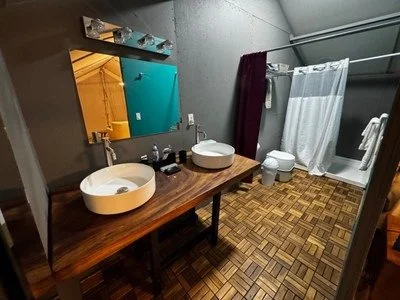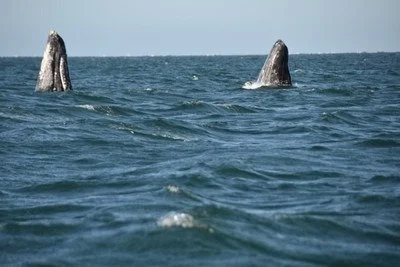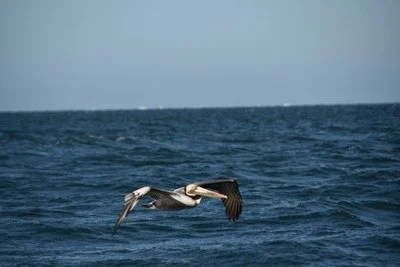Chapter 32: On San Ignacio Lagoon 2/18/25
Chapter 32: Day One On San Ignacio Lagoon
Tuesday, February 18, 2025
Alarm at 6:30. My Tent #10 is lovely. It is windy so the side flaps never rest and I am thankful for the space heater (the green thing on the floor). The en suite is quite adequate though, as you can imagine, the toilet is not of the civilized world flush variety--it is more like a marine toilet on a boat if you've ever experienced that. I have a coffee pot! But, the coup de grace is the electric blanket. No matter how much cold air wafts through the tent flap--and that's a good bit--it is warm as toast beneath that blanket.
Breakfast is at 7:00 before we assemble at 7:45 to get a jump on the 8:00 opening of the national park. This is our "official" first full day on the lagoon--yesterday was just a bonus because we were here and what else were they going to do with us?
There are 3 scheduled whale watching encounters offered every day. 8:00 until 9:30, beach the panga (yesterday at Playa Norte) and stroll around for a half hour or so and then back aboard from 10:00 till 11:30 before heading back to camp for lunch. If I somehow get tired of that, they say I can enjoy kayaking or paddleboarding across the lagoon in the mangroves. I can take a typical walk, mountain bike or kick back.
There is a cocktail hour (alcohol charged extra), sunset viewing (I saw the green flash last night), and the making of new friends around a fire pit. I could play billiards before or after dinner and enjoy an evening presentations by a naturalist. Last night's was about mobia rays but it was oversubscribed so that by the time I got there no place to sit remained. I chatted with other late comers instead. After dinner there was a light show of a clear starlight night sky unencumbered by ambient light other than that emitted from our canvas tents. Lovely.
This is “one of the best places on earth for whale watching,” according to The Oceanic Society based in California. Why and how? I was told to find and watch the video documentary "Whales of Gold," available on YouTube. I cannot do that while I am here because there is not adequate connectivity. Perhaps you could find it for me, watch it, and post a review in the "comments" section of this blog.
A major threat to all of this was quashed in 1994 when Mitsubishi Corporation and the Mexican government proposed a factory to produce seven million tons of industrial annually from 116 square miles of industrial development. Mitsubishi needed the salt to be produced here back in Japan to manufacture chemicals and PVC pipe. A massive international campaign stopped the plan.
In its place the government of Mexico expanded the 1972 San Ignacio Lagoon Nature Reserve and the 1988 El Vizcaíno Biosphere Reserve to include this place. As a result of that and other preservation efforts, gray whales began to recover and were removed from the endangered species list in 1994. Now, an estimated 1,500 arrive here and linger for three months.
A massive plant exists but far away in Guerrero Negro two hours north of here. Now wholly owned by the Mexican people to export salt globally, that plant is the largest in Mexico and the seventh-largest in the world. What is all that salt used for? Pharmaceuticals, chemicals, petrochemicals and even textiles require it for manufacture.
This, along with the close by Scammons Lagoon and Magdalena Bay, are “the last undisturbed breeding and calving lagoon” for the gray whale, according to the National Resources Defense Council. The tourism industry is tightly regulated to keep it that way. Government permits are required to visit these waters and permit holders can only be present sixteen small “pangas” at any one time. Of those sixteen, only two can be around any one group of whales at one time. (That's the human rule, the whales might have a different standard)
My panga captain is Tito. He is wonderful, watching over all of us but especially me--the old man of the group. Our naturalist is Scarlet. She, too, is great. A lot of punch wrapped up in a tiny package, she talks and explains when she needs to and is quiet when that works best. She tells us what we need to know. The resident population inside the San Ignacio Lagoon is now, according to the official "census" 34 single whales and six mother/calf pairs. We watch these grays engage in a couple of different behaviors that exceed the normal and expected spouting and surfacing as they pass by.
The first is known as "spy hopping." That occurs when the whale, nose up, slowly breaks the surface and rises so that the top ten feet of its torso stands straight up out of the water, pausing before slowly sinking back down below the surface. It is almost as if it is popping up to see what is going on. I got luck and snapped a shot of two grays spy hopping at the same time.
The second is "logging." That occurs when the whale simply floats on the surface doing absolutely nothing: its appearance from a distance is similar to what you would see if a log was floating there. This happens during a slack tide (when the tide is neither going out or coming in so there is no tidal current) and the whale is simply napping.
"Spy hopping" is a much more exciting behavior than "logging."
The morning was full of wonderful moments. We had lots of close encounters with whales.
But the magic came at the very end of the morning session, only minutes before our time was up and we had to, by park rule, leave the area.
I pet a whale.
There are no photographs to commemorate this because I laid the camera down so that I could lean over the side of our panga and stroke the mom who had brought her calf by for a visit. The encounter resembled all of the photographs you have just seen except for the fact that the whales closed the distance from the side of our panga from two or three feet to, well, no distance at all.
I have a wonderful video of this pair that I took later but I am unable to upload it here because of internet limitations. I will be able to upload it when I get back to the Cabo San Lucas Airport and will post it on the final chapter of this blog--Chapter 34: Fly Home.
I am exhausted from bouncing around in the panga, holding a camera out waiting to see if the whale will appear, straddling a bench seat which has no back which, please understand, is not good for my aching back. The exhaustion is, however, one of great happiness. I came to pet a whale and I did. And, don't you know, there is more time on the water ahead--another full day. I can't see how they will be able to top this day. It was just too fine. I will say this: I was happy to approach our camp at the end of the day. I have two hours to write all of this, to upload a bunch of photographs, to take a hot shower and make my way to the bar by 6:30--earlier actually--to get a seat for the "Whale Shark" presentation. B4, who is in Salt Lake City for a board meeting, along with Sam and James and Theresa and Karyl will testify that swimming with whale sharks is a kick. For that august group, it's a "been there, done that."





















